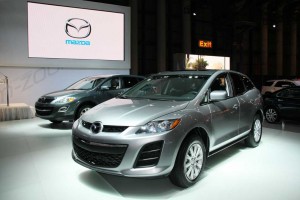
Mazda brought two new models to the New York, including the 2010 CX-7 with a 28 mpg I-4 engine.
With the introduction of a new, inline-four engine for its 2010 CX-7 crossover, Mazda takes a big step closer to its goal of offering “affordable” fuel economy to buyers around the world, the company’s chief executive declared, during a preview at the New York International Auto Show.
The 2010 Mazda CX-7 gets some minor visual tweaks, inside and out, for the upcoming model-year. But the real news is under the hood, where the company is adding an optional 16-valve, naturally-aspirated 2.5-liter I-4 engine. Delivering an estimated 21 mpg City and 28 Highway, Mazda Motor Co. CEO Takashi Yamanouchi hinted the new powertrain will come in at “even lower price point” than current offerings for the CX-7, though final pricing won’t be announced until just before the crossover’s autumn introduction.
 With consumers turning towards more fuel-efficient products – and governments around the world, including the U.S., raising mileage standards – Mazda is pushing to get out in front of its competition. The automaker has set a goal of boosting its current fleet average fuel economy 30% by 2016, noted Yamanouchi. To get there, he suggested, Mazda will take a number of steps: improving aerodynamics, lowering rolling resistance, switching to lighter-weight materials, and developing more efficient powertrains. The company’s next-generation gasoline engine is scheduled to debut at the October 2009 Tokyo Motor Show, and will enter production in 2011, the executive announced.
With consumers turning towards more fuel-efficient products – and governments around the world, including the U.S., raising mileage standards – Mazda is pushing to get out in front of its competition. The automaker has set a goal of boosting its current fleet average fuel economy 30% by 2016, noted Yamanouchi. To get there, he suggested, Mazda will take a number of steps: improving aerodynamics, lowering rolling resistance, switching to lighter-weight materials, and developing more efficient powertrains. The company’s next-generation gasoline engine is scheduled to debut at the October 2009 Tokyo Motor Show, and will enter production in 2011, the executive announced.
“It will achieve the same fuel economy as a (comparable) diesel,” Yamanouchi promised, adding that, Mazda’s next-generation diesels will match or exceed the fuel economy of comparable hybrids. The company’s second goal is to “be able to offer affordable fuel economy to 90% of the market,” not just the small fraction willing or able to afford costly technology, like hybrids.
The timetable for introducing some of the new technology into the U.S. has yet to be decided, cautioned Robert Davis, Mazda’s chief U.S. product planner. “We’re working on it,” he said, when asked if the company’s diesels will come to the States. It seems likely that will happen, but the timeframe is yet to be determined.
